Switching to a smart thermostat is a simple change that can dramatically cut your home’s carbon footprint. It learns your schedule, adjusts heating and cooling automatically, and reduces energy use by up to 20%. Sealing air leaks and improving insulation boost this benefit by preventing energy waste. Coupling this with switching to renewable energy sources or solar power can maximize your savings and environmental impact. Keep exploring to discover more easy ways to make your home greener.
Key Takeaways
- Install a smart thermostat to optimize heating and cooling, reducing energy use by up to 20%.
- Switch to renewable energy providers or install solar panels to significantly cut household carbon emissions.
- Upgrade to ENERGY STAR appliances to lower energy consumption by 30% or more.
- Use native plants in landscaping to decrease water and energy needs, supporting biodiversity.
- Support sustainable transportation like electric vehicles, reducing emissions by about 60–70%.
Install a Smart Thermostat to Optimize Heating and Cooling
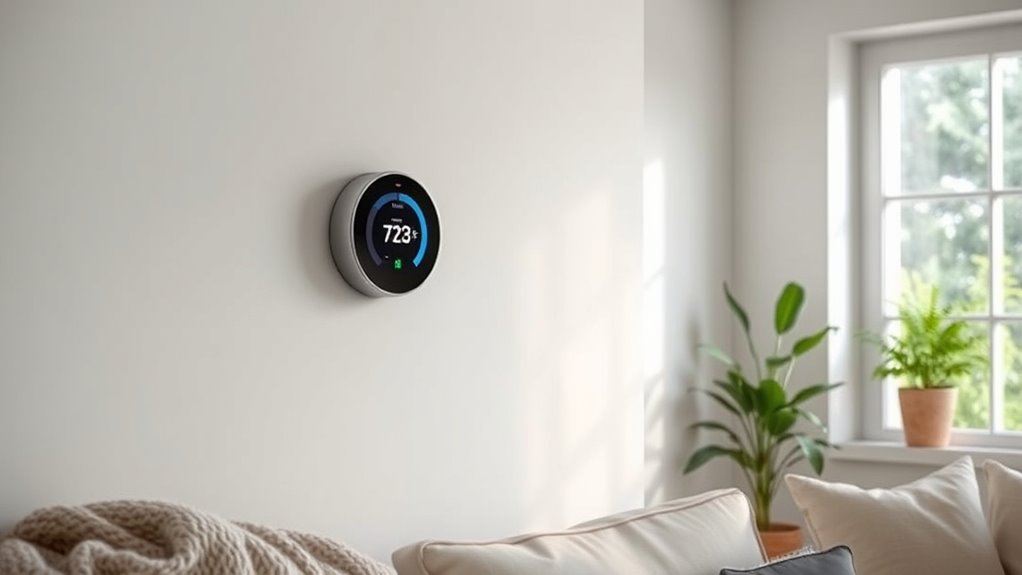
Installing a smart thermostat is one of the easiest ways to cut your home’s energy use and reduce carbon emissions. This device learns your schedule and preferences, automatically adjusting heating and cooling to optimize energy efficiency. By preventing unnecessary heating or cooling when you’re away or asleep, a smart thermostat can reduce your home energy consumption by up to 20%. It seamlessly integrates with renewable energy systems, helping you maximize clean electricity use and lower your carbon footprint. Additionally, smart thermostats can be integrated with automation technologies, further enhancing their ability to optimize energy use throughout your home. Plus, it offers significant cost savings—some homes save hundreds annually on energy bills. Switching to a smart thermostat is a simple, effective step toward a greener home. With improved control over your heating and cooling, you not only save money but also contribute to a healthier environment.
Seal Air Leaks and Improve Home Insulation
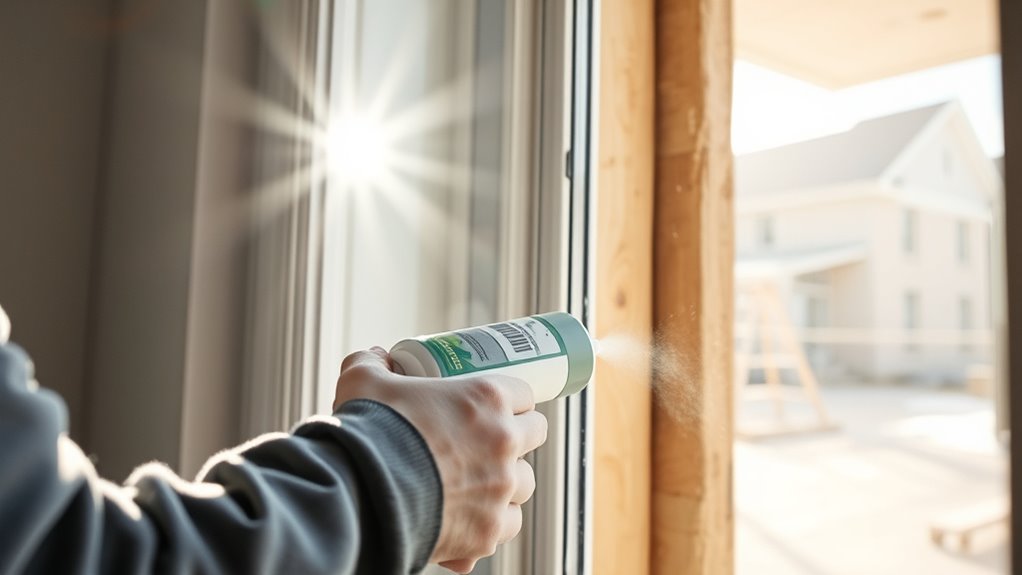
Start by locating hidden leaks around your windows, doors, and outlets, as they can substantially impact energy use. Sealing drafts with weatherstripping or caulking is an easy, cost-effective way to block unwanted airflow. Improving your insulation helps keep temperatures steady, reducing the need for heating and cooling and lowering your carbon footprint.
Identify Hidden Leaks
Have you ever noticed drafts or uneven temperatures in your home? That’s a sign of hidden air leaks. Identifying these leaks is essential for sealing your home’s thermal boundary and boosting energy efficiency. Check around windows, doors, electrical outlets, and ductwork with simple visual inspections or smoke tests to locate leaks. Once identified, sealing these gaps with weatherstripping or caulking is a cost-effective way to improve home comfort. Upgrading insulation in your attic, walls, and basement also helps your home retain heat in winter and stay cool in summer. Properly sealed and insulated homes waste less energy, lowering bills and reducing your carbon footprint. Taking the time to find and seal these hidden leaks makes a noticeable difference in your home’s overall efficiency.
Seal Drafts Effectively
Sealing air leaks is one of the most effective ways to improve your home’s insulation and reduce energy waste. By sealing drafts around windows, doors, electrical outlets, and attic hatches, you create a stronger thermal boundary that keeps warm or cool air inside. Here’s how to do it:
- Use weatherstripping on doors and windows to block gaps.
- Apply caulking or foam sealants around stationary fixtures and cracks.
- Test for leaks with smoke pencils or dollar bills to identify hidden drafts. Incorporating traditional knowledge about natural materials can enhance your sealing methods.
- Insulate exposed outlets and switch plates to prevent heat loss.
- Regularly assess and rotate items to prevent clutter buildup which can impede insulation effectiveness. Understanding the importance of home insulation can further enhance your efforts in reducing household emissions and improving energy efficiency. Incorporating essential oils like eucalyptus or peppermint in your home air quality can also support a healthier environment. These simple steps not only enhance your energy efficiency but also cut your heating and cooling costs. Properly secure leaks ensures your home stays comfortable while reducing household emissions and improving overall insulation.
Boost Insulation Quality
Improving your home’s insulation quality by sealing air leaks and upgrading insulation can substantially cut energy loss. Proper insulation in walls, attics, and floors creates a more effective thermal boundary, helping your home retain heat in winter and stay cool in summer. Air sealing gaps around windows, doors, and ductwork prevents drafts that make your HVAC system work harder. This boosts energy efficiency and reduces strain on your heating and cooling systems. Additionally, using energy-efficient materials can further enhance your home’s thermal performance. As a result, your energy bills can drop by up to 20%, saving you money and lowering your carbon footprint. Many programs offer free or low-cost insulation and air sealing services for qualified homeowners, making this simple change accessible and impactful for sustainable living.
Switch to a Clean Energy Provider
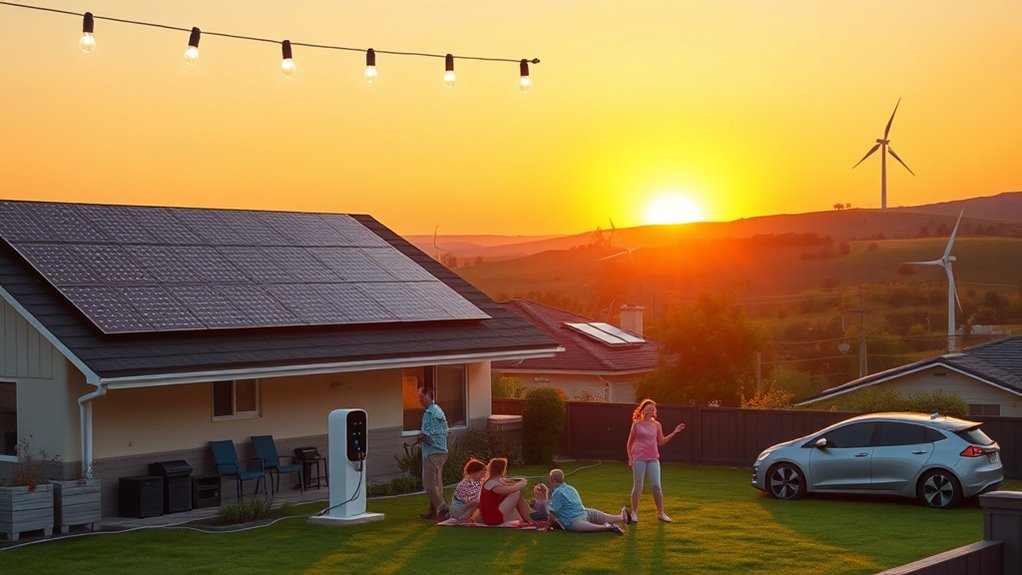
Switching to a clean energy provider is one of the simplest ways to cut your home’s carbon footprint. By choosing a provider that offers renewable energy, you can power your home with wind or solar, drastically reducing emissions. Here’s how it benefits you:
Switching to renewable energy cuts your home’s carbon footprint and supports a sustainable future.
- Sign up for green energy plans that often cost the same or less than standard options.
- Support renewable energy sources, helping to accelerate the shift to a sustainable grid.
- Lower your household greenhouse gases by up to 80%, according to the EPA.
- Make sustainable choices that not only reduce emissions but also enhance your home’s value and appeal.
- Utilizing AI security can help ensure your energy data remains protected as you transition to cleaner energy options.
- By choosing renewable providers, you contribute to a healthier environment and promote the growth of clean energy infrastructure. Incorporating energy efficiency measures can further maximize your environmental benefits and reduce overall consumption.
- Engaging in diversification strategies by selecting multiple renewable sources can further optimize your energy use and resilience.
- Understanding the performance tuning laws can help you make smarter adjustments to your energy system for maximum efficiency.
This switch is a straightforward step toward a cleaner environment while enjoying more environmentally conscious and cost-effective energy options.
Upgrade to Energy-Efficient Appliances
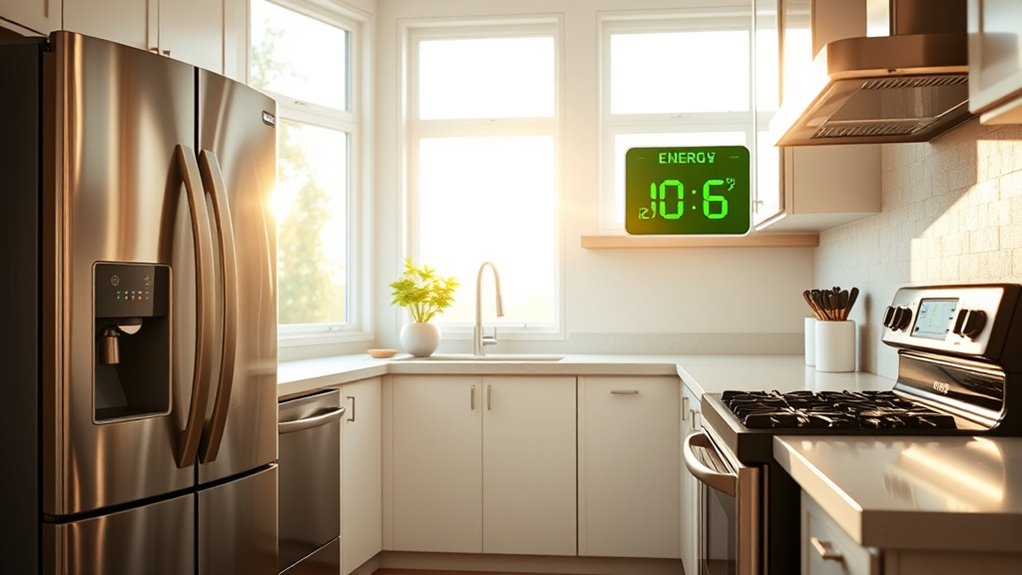
Have you considered upgrading your appliances to ENERGY STAR-rated models? Switching to energy-efficient appliances can reduce household energy use by 30% or more, which markedly cuts your greenhouse gas footprint. Modern ENERGY STAR refrigerators, washers, and dishwashers consume 20-50% less electricity than older models, leading to noticeable savings on utility bills. An appliance upgrade not only benefits your wallet but also supports sustainable practices by lowering energy demand and resource consumption. These appliances are designed to perform efficiently and last longer, making them a smart investment. By choosing energy-efficient appliances, you take a simple step toward reducing your home’s environmental impact while enhancing performance and durability. Additionally, incorporating energy-efficient technology can further optimize your household’s energy consumption and reduce overall environmental impact. Implementing proper storage practices for food and beverages can also minimize energy waste and extend the lifespan of your appliances.
Use Solar Power for Electricity Generation
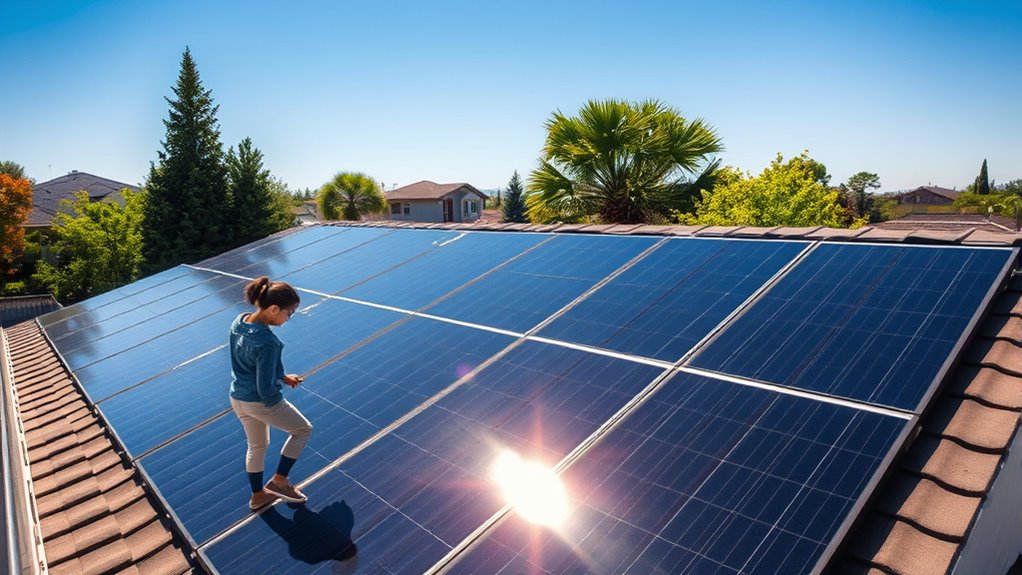
Installing solar panels lets you turn sunlight into clean electricity, reducing your reliance on fossil fuels and lowering your home’s carbon footprint. With costs dropping and efficiency improving, it’s more affordable and effective than ever. Plus, many regions offer incentives that make switching to solar even more financially attractive. Additionally, integrating solar energy can diversify your energy sources, providing greater stability and security for your household. Utilizing advanced solar technologies can further enhance energy output and efficiency, maximizing your investment. Modern solar systems often incorporate microinverters that optimize power conversion and increase overall system performance. Embracing innovations like performance-boosting components can help you get the most out of your solar setup. The growing emphasis on sustainability initiatives at events like Burning Sands Festival highlights the importance and benefits of adopting renewable energy solutions.
Installing Solar Panels
By adding solar panels to your home, you can generate clean, renewable electricity that markedly cuts your carbon footprint. Installing solar panels is a sustainable choice that helps reduce greenhouse gas emissions and reliance on fossil fuels. Consider these benefits:
- A typical 6-kilowatt solar panel system can produce 9,000 to 12,000 kWh annually, replacing grid power.
- Solar panels can pay for themselves within 6 to 10 years through energy savings and tax incentives.
- Using solar power considerably reduces your home’s greenhouse gas emissions.
- Installing solar panels can increase your home’s value by around 4% and attract eco-conscious buyers.
- Renewable energy sources like solar power are essential for a sustainable future and reducing dependence on fossil fuels.
This simple upgrade makes your home more sustainable while making a meaningful impact on reducing energy-related environmental harm.
Benefits of Solar Generators
Using solar generators to produce electricity offers a clean, efficient way to power your home, especially during outages or in remote locations. They convert sunlight directly into electricity, producing zero emissions and helping you reduce your carbon footprint. Solar generators provide reliable backup power without relying on fossil fuels, ensuring continuous energy during emergencies. By using solar power, you decrease dependence on grid electricity, which often comes from non-renewable sources, further reducing emissions. Their energy efficiency, minimal maintenance, and declining costs make them a smart, sustainable choice. Below is a visual comparison:
| Feature | Benefits |
|---|---|
| Zero emissions | Reduce your household’s carbon footprint |
| Cost-effective | Lower fuel and maintenance costs |
| Renewable energy | Harness free sunlight |
| Remote use | Ideal for off-grid locations |
| Reliability | Consistent backup during outages |
Replace Old Water Heaters With Heat Pump Models
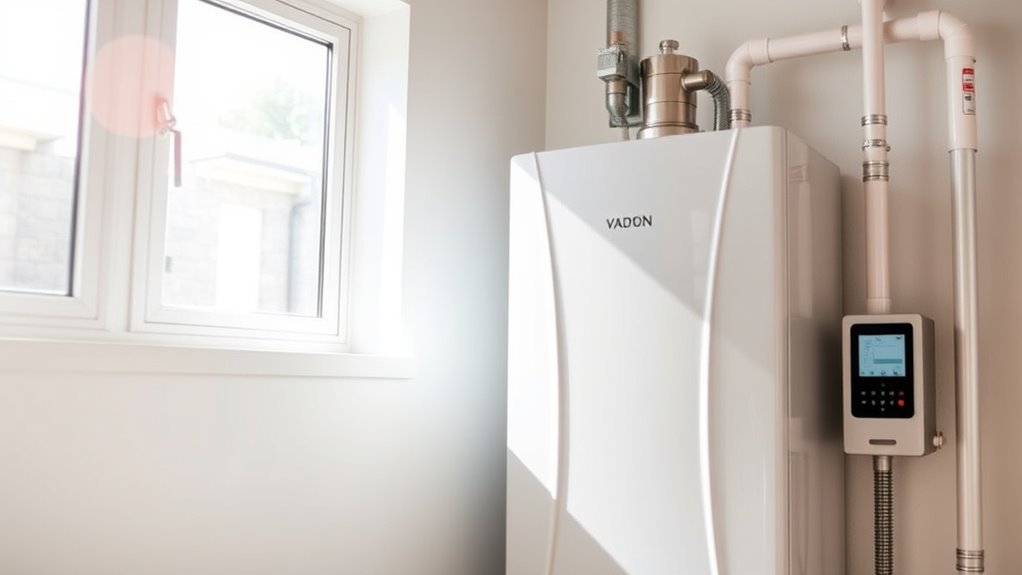
Replacing your old water heater with a heat pump model is one of the simplest ways to cut your home’s energy use and emissions. These units are 2–3 times more energy-efficient than traditional models, helping you reduce your carbon footprint. When you switch to a heat pump water heater, you’ll:
- markedly lower household water heating-related emissions, by up to 50%
- Use ambient air to heat water, saving energy
- Qualify for rebates or incentives, offsetting costs
- Make your home more sustainable with minimal effort
Drive an Electric Vehicle or Support Sustainable Transportation

Switching to an electric vehicle (EV) or supporting sustainable transportation options can substantially cut your household’s carbon footprint. An electric vehicle reduces emissions by about 60-70% compared to gasoline cars, especially when charged with renewable energy. EVs produce zero tailpipe emissions, saving roughly 4.6 metric tons of CO2 annually per vehicle—equivalent to planting 100 trees. Choosing sustainable transportation methods like biking, walking, or public transit can cut your daily commute’s carbon footprint by up to 50%. This shift also helps reduce dependence on fossil fuels and improves air quality, leading to healthier communities. Incentives and rebates make EVs more affordable, accelerating the shift toward cleaner transportation. Supporting sustainable options not only benefits the environment but also promotes a healthier, more sustainable lifestyle.
Adopt Natural Cleaning Products and Reduce Chemical Use

Switching to natural cleaning products can improve your indoor air quality and protect your health by reducing exposure to harmful chemicals. It also helps cut down on plastic waste from store-bought cleaners, supporting a cleaner environment. Using simple ingredients like vinegar and baking soda makes your home safer and more eco-friendly.
Safer Indoor Air Quality
Choosing natural cleaning products like vinegar, baking soda, and lemon can markedly improve your indoor air quality by reducing harmful chemical emissions. These alternatives avoid synthetic fragrances and harsh chemicals found in conventional cleaners, which often release VOCs that worsen air quality. To enhance respiratory health and create a safer environment, consider:
- Switching to chemical-free products that emit fewer VOCs.
- Using DIY cleaning solutions to control chemical ingredients.
- Purchasing in bulk to reduce plastic waste and packaging.
- Ensuring good ventilation during and after cleaning to disperse airborne toxins.
Reduce Plastic Waste
Have you considered how your cleaning routine impacts plastic waste? Switching to natural cleaning products like vinegar, baking soda, and lemon reduces the need for plastic bottles and chemical-laden containers, lowering plastic waste. Making your own solutions in reusable containers eliminates single-use plastic bottles, directly cutting down plastic pollution. Buying cleaning supplies in bulk helps you reduce packaging waste, which lessens the amount of plastic ending up in landfills and oceans. Replacing disposable wipes and paper towels with washable cloths not only decreases plastic waste but also promotes sustainable habits. Supporting brands that produce eco-friendly, plastic-free cleaning products encourages a broader shift toward reducing plastic use. By adopting these simple changes, you contribute to less plastic pollution and foster a healthier, more sustainable home environment.
Implement Behavioral Changes to Save Energy

Implementing small behavioral changes can make a significant difference in reducing your home’s energy consumption. By adopting simple energy-saving tips, you can lower household emissions and cut power consumption. Here are four effective ways:
- Wash clothes in cold or warm water instead of hot to reduce energy use by up to 90%.
- Unplug electronic devices and chargers when not in use to prevent phantom energy consumption that accounts for 5-10% of household electricity.
- Adjust your thermostat by just 1-2°F seasonally to decrease heating and cooling energy consumption by 3-5%.
- Switch to energy-efficient LED bulbs and turn off lights and appliances when not needed to cut down on unnecessary energy use.
These behavioral changes are quick, cost-effective, and impactful in reducing your household’s carbon footprint.
Incorporate Native Plants and Sustainable Landscaping

Incorporating native plants into your landscaping naturally reduces water and energy use by thriving in your local climate. Native plants require 30-50% less water than non-native species, cutting down on irrigation needs and energy consumption. By choosing native plants, you support biodiversity and create essential habitat for local pollinators, strengthening ecosystem health. Sustainable landscaping with native species minimizes the use of chemical fertilizers and pesticides, decreasing chemical runoff and energy use. These plants are adapted to the climate, reducing the need for heating or cooling nearby structures. Additionally, native plants help sequester carbon in soil and biomass, contributing to lower atmospheric CO2 levels. Embracing native plants in your landscape is a simple yet powerful way to enhance energy efficiency and reduce your home’s carbon footprint.
Frequently Asked Questions
How Can We Reduce Our Carbon Footprint at Home?
You can reduce your carbon footprint at home by making a few practical changes. Conduct a home energy audit to spot waste, upgrade to high-efficiency appliances, and switch to renewable energy sources like solar. Simple actions like unplugging devices and using cold water for laundry also help. Seal air leaks, add insulation, and be mindful of energy use daily—these steps add up to a greener, more sustainable home.
What Is One Way Your Household Could Reduce Its Carbon Footprint?
Did you know that upgrading to energy-efficient appliances can cut your household electricity use by 30% or more? You can markedly reduce your household’s carbon footprint by making this change. It’s an easy step that saves energy and lowers emissions. Plus, combining it with smarter habits like unplugging devices when not in use boosts your impact. Small adjustments like these make a big difference for the environment and your wallet.
What Changes Can You Make to Reduce Your Carbon Footprint?
You can reduce your carbon footprint by making simple yet impactful changes around your home. Switch to LED bulbs to cut energy use, seal leaks and improve insulation to lower heating and cooling needs, and consider renewable energy options like solar panels or a green provider. Additionally, practice habits like washing clothes in cold water and unplugging unused electronics to save even more emissions. Small actions add up to a big difference.
How to Reduce Housing Shelter Footprint?
Did you know that upgrading to high-efficiency HVAC systems like heat pumps can cut household emissions considerably? To reduce your housing shelter footprint, focus on improving insulation and sealing air leaks, which can lower energy use by 25–40%. Choose energy-efficient housing options like condos or townhouses, and incorporate sustainable materials in renovations. These steps not only boost comfort but also make a meaningful impact on lowering your home’s environmental footprint.
Conclusion
By making these simple changes, you’re not just reducing your carbon footprint—you’re joining a movement toward a healthier planet. While upgrading appliances or switching to solar power can seem like big steps, small habits like using natural cleaners or planting native plants make a difference too. It’s easy to think one effort isn’t enough, but remember: just as a single drop creates ripples, your actions collectively can transform our environment.









